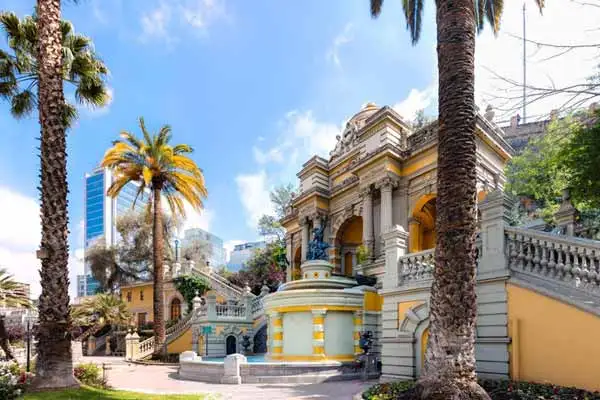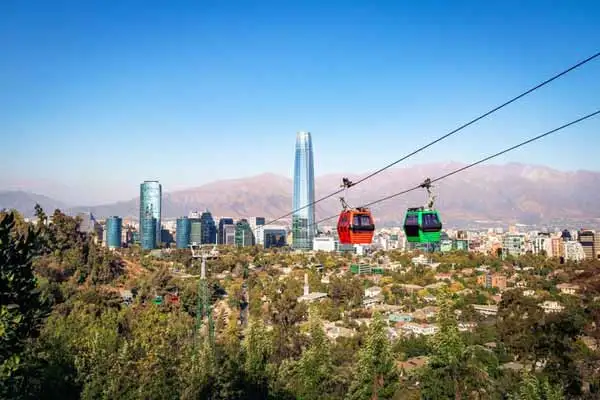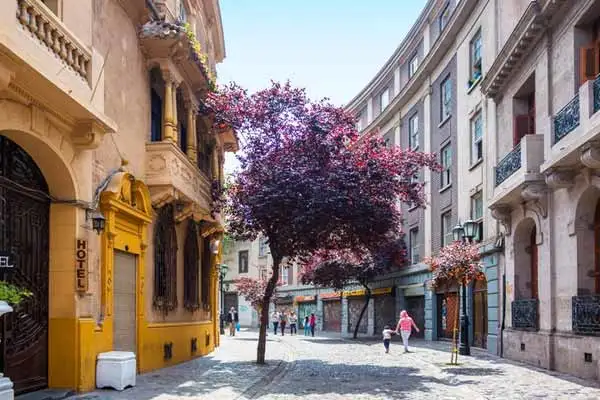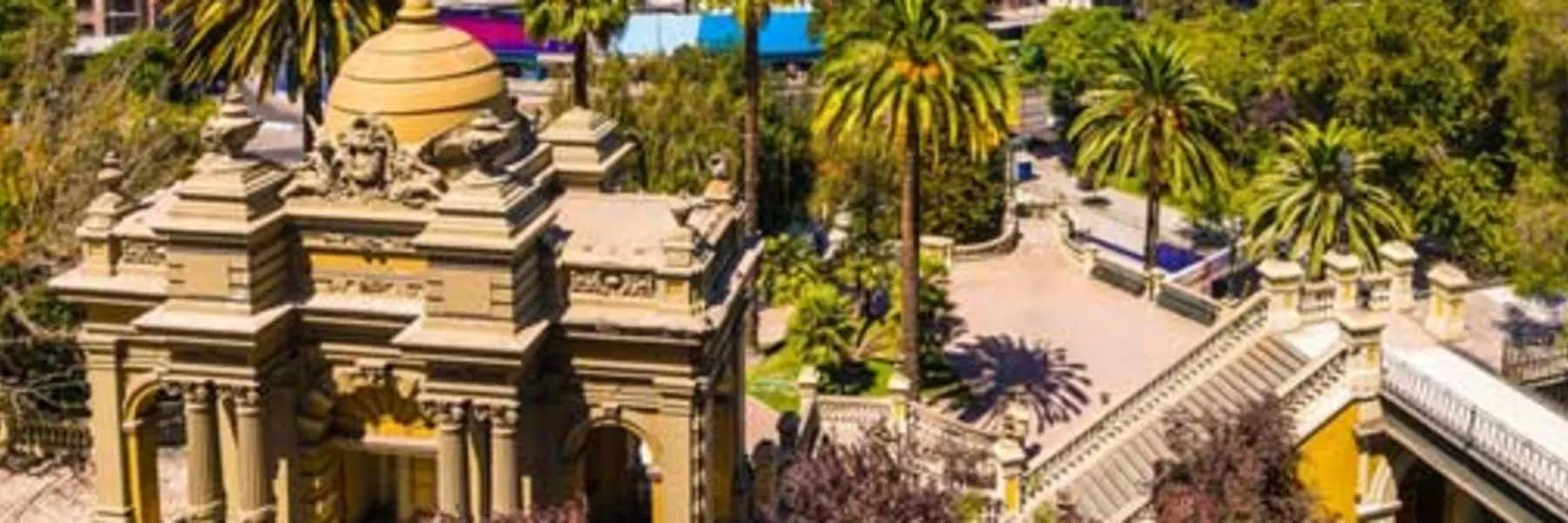Is Santiago, Chile on your list of potential places to retire? If so, you’ll be happy to find out about all the things it has to offer. From its lovely green spaces, scenic hills, walking paths, and bike lanes, Santiago is a stone’s throw away from some of the world’s best vineyards and wineries. Residents also enjoy an amazing view of the Andean mountains on the east and relaxing beaches like Viña del Mar less than two hours west of the city center.
Although Santiago was officially founded in 1541 by Spanish settlers, activity in the area dates back to a least 800 AD when the Picunche people established farming communities along the Mapocho River. Santiago didn’t see that much growth until the 19th century when, after the War of Independence, it expanded to the north, south, and west and was declared the capital of Chile by Bernardo O’Higgins.
Santiago de Chile has a population of almost 6.9 million residents. The capital city is one of the biggest in South America — about 85% of Chileans live in the metropolitan area — and offers an impressive metro system managed by DTP Metropolitano that operates six lines and 118 connecting stations across 26 districts."
In addition to a high-quality transportation system, the city offers dozens of unique neighborhoods, including the Downtown historical center, the cultural hub of Bellas Artes and Lastarria, Bellavista, Providencia, Nuñoa, Las Condes, Vitacura, and more. Each neighborhood is unique and offers access to great restaurants, attractions, and amenities, which makes traveling on foot a fantastic option. There are also buses, taxis, ride-share options, and well-developed biking and hiking trails.
Chile has four seasons and its residents enjoy warm, dry summers from October to March, and cool, humid winters between April and September. The temperature rises to daytime highs in the 80s F and lows in the 90s F at night, although during the colder months, temperatures can plunge to near freezing. Chile is known for its skiing and snowboarding resorts and Santiago boasts several mountain tops like Cerro Manquehue where you can walk through attractive trails, and the impressive Cerro Leonera, which reaches a towering 4,954 meters (16, 312 feet). In the downtown area, Cerro San Cristobal rises about 985 meters above sea level and visitors can use a 100-year-old cable car system that carries them up the steep hill to a spectacular view from the top. Hiking trails are also available there and take about an hour to complete. The National Zoo of Chile is also located in Cerro San Cristobal.
Lifestye in Santiago

Despite the dense population, after only a few weeks in the city of Santiago, you start to feel at home. The city is a cultural, political, and financial hub for Chileans and is home to the largest concentration of immigrants in the country (including expats). One of the most impressive districts in the city is the downtown core, which is home to some of the most memorable landmarks Chile has to offer. There, you’ll discover Santiago’s Cathedral, a construction that dates back to the mid-18th century. You’ll also find the Castillo Hidalgo, a castle originally built to protect the city and later restored as a space for residents to gather for social events.
At walking distance from the historical center is the Plaza de Armas, the city’s main square. The main building is surrounded by government offices and commercial centers. The neighborhood has plenty of options for those who crave nightlife or just want to grab a bite to eat. In nearby Providencia, you’ll find a series of outdoor sculptures and art exhibits throughout the Parque de las Esculturas. Some of the pieces were designed by Chilean artists like Francisca Animat, Mariana Tocornal, and Marcela Correa. The sculpture park is located near the Sculpture Park Museum and is a 20-minute subway ride away from Bellas Artes, where the equally impressive Parque Forestal, a lush national park stretches along the Mapocho River.
Santiago de Chile offers high-quality healthcare, walkable neighborhoods and hiking trails, and lots of great shopping centers. You probably won’t need to own a vehicle. Wherever you live, you’ll have easy access to public transportation, grocery stores, shopping malls, and hospitals. While Chile is perhaps one of the more expensive Latin countries to live in, it’s also among the safest on the planet. According to the Global Peace Index, it ranks 27th in personal safety along with Uruguay. As a resident of the capital city, you’ll also have the convenience of the Comodoro Arturo Merino Benítez International Airport, located 10 miles from the city center.
The capital city has no shortage of art galleries, theatres, museums, restaurants, and bars. There are also various shopping malls such as Vivo El Centro, Mall Costanera Center, and Parque Arauco, and you can easily access fresh fruits and vegetables, meats, cheeses, wines, fresh baked goods, and desserts in smaller markets.
Get Your Free Report on the World's Best Places to Retire:
Get Your Free Report on the World's Best Places to Retire:
Learn more about the best places in the world to retire in our daily postcard e-letter. Simply enter your email address below to sign up for our free daily postcards and we'll also send you a FREE report on The World's Top 10 Retirement Havens.
By submitting your email address, you will receive a free subscription to IL Postcards and special offers from International Living and our affiliates. You can unsubscribe at any time, and we encourage you to read more about our Privacy Policy.
Check out our video below - Guide to Santiago, Chile:
Real Estate in Santiago

If you’re planning to buy a home, depending on your budget, you will want to work with a real estate agent to find the right neighborhood and home for you. Real estate agencies dealing with foreign buyers have had a presence in Santiago de Chile for decades and are experienced in residential and commercial properties. The average price per square meter in Santiago is $2,400, but it can vary between $1,600 and $3,000. Chileans use a unit of account called the Unidad de Fomento (UF) to simplify the calculation of real estate prices. Most prices for houses and apartments will be advertised in UF. The UF is managed by the national tax authority and is updated daily. The amount is regularly adjusted for inflation. If you sign a mortgage, you should make sure the value is up to date and in line with the UF to avoid having to go back to the bank to pay the difference later.
To purchase a property in Chile, you will need to first do a property search, then make an offer in writing to the seller. If the seller is interested, a promise to purchase or sell can be notarized and submitted along with a 10% deposit. As the buyer, you should then ask your lawyer to analyze the documents related to the property and verify the ownership before going further. Next, you will need to sign the purchase contract in front of the notary and deposit the balance (90%) in the form of bank checks called vale vista. Your money will remain on deposit until the process is complete.
The seller’s bank will then authorize the release of the mortgage and the contract will be registered with the authorities. The title can then be issued to you and the notary will release your deposit. As a foreigner, you are entitled to buy real estate in Chile whether you are a resident or not. You will need to provide your passport number and should ask for a RUT from the tax service. You can also obtain a mortgage if you hold a permanent residence. It will be difficult to do so if you are a non-resident and you may need to obtain the loan from a bank in your country of origin. Keep in mind that buying real estate in Chile doesn’t automatically give you the right to obtain a visa.
Cost of Living in Santiago

Living in Santiago provides a comfortable modern urban lifestyle for less than you would pay in a similar-sized city like New York City, Toronto, or Barcelona. While the cost of living is more expensive than 63% of Latin American cities, it’s cheaper than the majority of cities around the globe. If buying a home isn’t in your plans, you’ll have many rental options across the city. On average, when renting, you can comfortably live on $1,808 as a single person and $2,746 as a couple. The estimates below are based on one and two-bedroom apartments. If you’re planning a more upscale lifestyle, your cost of living will depend on several factors, including the neighborhood you choose, whether you drive or use public transit, and whether you like to eat out often or cook your meals.
In a recent listing, a 398-square-foot apartment in Providencia was listed at $378 per month and a two-bedroom 301-square-foot unit with two bathrooms in Vitacura was listed at $1,892. An 840-square-foot three-bedroom apartment in Providencia was listed at $630, while another at 1,324-square feet apartment with three bathrooms was listed at $1,000 per month. Keep in mind the winter months in Chile may be colder and you may need to pay for heat. Utilities for two people cost an average of $77 and for a single person, $55. The monthly cost of Internet service is about $17.
Large supermarket chains like Walmart are available in Santiago and offer local and imported products and have a wide range of choices but tend to be pricier. In smaller supermarkets like Jumbo, Lider, or Unimarc, you will find more affordable selections. You can also find fresh inexpensive vegetables and fruits in La Vega, the city’s biggest produce market. The average restaurant will charge around $15 for lunch, and dinner at an upscale eatery will likely run you around $37 a person.
Chile has a multi-tiered public healthcare system, and most expats prefer to buy private insurance to have access to private hospitals. Several factors determine how much you’ll pay for private insurance, including which company you choose and how comprehensive you want your plan to be. If you register with the national public system (FONASA), you will likely pay around 7% of your income.
Here’s a sample budget in U.S. dollars for a single person and a couple living in Santiago:
| Expense | U.S. $ |
| Housing (rental of a three-bedroom apartment) | $700 |
| Utilities (heat, electricity, internet) | $72 |
| Cell phone service | $26 |
| Groceries | $400 |
| Transportation (public transit) | $50 |
| Clothing and miscellaneous | $100 |
| Entertainment | $300 |
| Healthcare (public) | $160 |
| Total per month: | $1,808 |
Get Your Free Report on the World's Best Places to Retire:
Get Your Free Report on the World's Best Places to Retire:
Learn more about the best places in the world to retire in our daily postcard e-letter. Simply enter your email address below to sign up for our free daily postcards and we'll also send you a FREE report on The World's Top 10 Retirement Havens.
By submitting your email address, you will receive a free subscription to IL Postcards and special offers from International Living and our affiliates. You can unsubscribe at any time, and we encourage you to read more about our Privacy Policy.
Related Articles
The Ultimate Expat Guide to Chile
